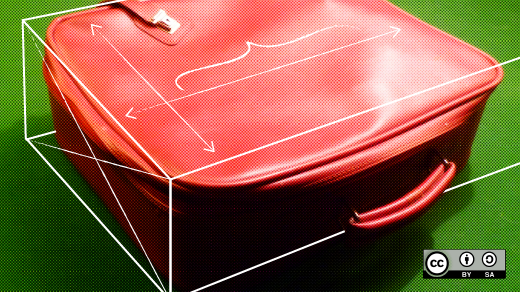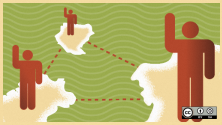Spring has sprung in the Northern Hemisphere, meaning tech conference season is just around the corner. LinuxFest Northwest, OSCON, OpenStack Summit, Write the Docs, and PyCon US are just a few of the inspiring events happening in the next few weeks.
A lot of us are likely to be hitting the roads, the skies, or the tracks to travel to one or more technical conferences this year. As exciting as travel can be, it can be stressful as well. Thankfully, there are things you can do to make the process easier and more pleasant.
In 2016 alone we—your humble authors—cumulatively logged enough miles to circumnavigate the globe multiple times. Before you take off for your next tech event, try some of these packing and travel tips, which we've learned the hard way so you don't have to.
General packing approach
How and what you pack can have a dramatic impact on your quality of life while traveling. Some swear by special travel-ready clothing, packing cubes, special luggage, or other packing lifehacks. While these can help, you don't have to lay out a lot of cash in order to have a good packing experience. More helpful than any gadget is a little preparation and a few techniques.
Do I need this?
The biggest problem most people face with packing is that they pack too much. If you've reached the end of your trip and you have not used every item in your luggage, you've probably over-packed. Over-packing adds weight and complexity to your trip. The more you pack, the more you're likely to forget in the hotel when you leave. Also, it can mean that you must use a larger suitcase. For some airlines, that will mean a fee for checked baggage.
Instead, if you ever find yourself asking the question, "Will I need this?" when considering adding an item to your suitcase, train yourself to default to the answer, "NO!" The what-if items are rarely used and are simply a burden. Odds are very good that the conference you're attending is in an urban area, so if it should turn out that you really did need that item you can most likely either borrow or buy it at your destination. Our experience shows, however, that only very rarely will you need to do that.
Planning outfits
To make the best use of your limited luggage space, plan out your outfits in advance. Lay them all out on your bed, floor, or wherever to get a good view of what you have in mind. This allows you to find some items (like jeans, skirts, or cardigans) that you can wear multiple times and save space. Choose neutral colors for easier mixing and matching, then accessorize with small colorful items like a hat, scarf, socks, or jewelry.
If one or more of your travel days includes a more formal event (such as an interview or meeting with a client), choose nice clothing that does not need ironing, or send that item out for a press the day before you need it. Hotel irons and ironing boards are of... questionable quality. The last thing you need when you're trying to impress is a lukewarm iron or, even worse, an iron-shaped burn on your one nice shirt.
If your travel spans more than one week, considering packing outfits for a smaller number of days and then using onsite or nearby laundry facilities. Having clean clothes during a long trip feels good, and doing laundry also builds a pause into what may be a very hectic time. We all can use a little mental space from time to time.
When planning your outfits, work very hard to minimize the pairs of shoes involved. Shoes take up a lot of space in your luggage, and often many pairs you pack turn out to be unnecessary. Having a spare pair on hand can be helpful if you're headed somewhere with rain or other inclement weather, but otherwise, try to keep the number of pairs down to the one you'll be wearing when you leave home. That pair, by the way, should be tried and true. Tech conferences involve a lot of walking and standing and are a very bad place to be breaking in a new pair of footwear, no matter how cute they are.
How to pack your clothes
Now that you know what you'll be wearing, how you place these items in your luggage matters. Rolled clothing saves space. Some claim rolling also minimizes wrinkles, but the best way to do that is not to pack clothing that will wrinkle in the first place. Rolling serves another purpose: it allows for the better organization of your clothes. Outfits are easier to group together when all the items are rolled, making it easier to grab something to wear after a long night of conference networking.
For this to be most effective, all clothes should be rolled, including socks and underwear. If you've chosen to bring extra shoes, the empty space inside of them is the perfect place for those socks and underwear. This little trick makes the best use of your luggage and gives you just a little more room for other items.
Of course, there's more to packing than just clothing. If you travel more than once or twice a year, it can make sense to buy spares of certain items and keep them in your luggage so you never forget to pack them. Keeping a spare laptop power brick, charging cables, belt, umbrella, toiletries, etc. in your luggage can really help with your peace of mind while packing and traveling.
Carry-on or checked bag?
In general, you want to save your (hopefully minimal) bulky clothing items for you to carry onto your transport. Consider two or three layerable and packable coats instead of one massive one that is rated for Antarctica (unless you're actually going to Antarctica—also please share your penguin pics with us). You don't want to arrive somewhere cold without anything warm, so bring one layer and either a packable shell or a scarf to beef up your in-flight hoody. If you're going somewhere that you'll need boots, consider wearing them on the plane. Try zip-up boots for flying instead of pull-ons because they're quicker to deal with at security.
Speaking of which, when you're assembling your carry-on luggage you'll want to optimize for security. TSA isn't generally moved by, "But I have to be on this flight, the women's breakfast is at 6 a.m. tomorrow morning!" Make sure all blades, tools, scissors and liquids, above the allowable amounts, are out of all of your pockets and carry-on bags. Check the most recent TSA-allowed lists online, and if you think something might raise a TSA eyebrow, consider not bringing it. If you travel often, consider getting TSA Pre-Check. Global Entry is well worth it even if you only plan to come through U.S. customs in Miami once (no one does it twice if they can help it). Finally, if you are traveling internationally, make sure your passport will be good for six months and that you have a Visa if you're going somewhere that you'll need one.
Think about the small things that will make or break an unexpected layover or lost luggage situation for you, and then put them into your carry on. For instance, you may want to pack a clean shirt and new undies if you're just chilling when you arrive. Or if you've got a fancy dinner/pool party/workout session scheduled for five minutes after arriving via a three-flight itinerary, then you should pack whatever you were going to wear for that activity.
Pack power cables for your devices so that you can work or check email when you are separated from your checked luggage. Also, a multi-region power adapter is cheap, compact, and easy to carry. Get one for your carry-on and you'll never find yourself with the wrong adapter when you're traveling internationally. This is especially helpful if you end up on a long unexpected layover with different plugs than either your destination or departure point.
Tips especially for speakers
Are you traveling to a conference because you're presenting at it? There are some special travel and packing consideration for speakers.
For women, make sure your speaking outfit includes pockets (or pocket proxies). Many conferences use lavalier microphones. If you don't have a pocket, then things can get a little awkward as you try to find somewhere to clip the battery/transmitter pack.
Always travel with at least one video adapter for connecting your laptop to the projector. Conferences usually have these available, but they're often in limited supply and sometimes it can be difficult to find A/V staff to ask for an adapter. We recommend having adapters for both VGA and HDMI projectors because this covers nearly all of the possibilities you'll currently encounter.
Technical snafus are lurking around every corner, but if you have a Plan B, a snafu doesn't have to turn into a tragedy. Back up your presentation, in multiple formats if possible, both on a USB drive (which you keep with you at all times) as well as somewhere on the internet. If you use speaker notes for your presentation, export those, print them off and carry them with you as an additional safety net. More than once we've have been caught by slides displaying well but speaker notes not. Strange things can happen when you're at that podium.
Some of the things speakers should pack and keep near to hand are less obvious. The last thing you want on the day of your talk is to be hunting around for something small but irritating in its lack. These are things that might seem innocuous, but being able to find them quickly can do excellent things for your pre-presenting state of mind. Your list will depend on your needs, but some of the items you can consider are hair ties, ibuprofen or other medication, flossers or a small toothbrush, business cards, a laptop power cord, a water bottle, spare contacts or glasses, and extra batteries for your presentation clicker. It's easy to build a small kit of these objects in a zip-top or other small container then move it to whichever bag you carry when you present.
With all this talk of what to pack, there's one thing you may be able to avoid packing: If the conference asks for your T-shirt size when you register, you can probably safely assume that you can pack one fewer shirt for your trip because you'll receive one onsite.
An ounce of prevention
A small amount of planning can help make sure that minor mishaps don't become major inconveniences. Make a photocopy of your passport to keep in your suitcase or have a digital copy in a secure location. Once you arrive, don't carry your passport around.
If you have multiple credit cards then leave one in your room (instead of carrying them all) so you have a backup in case your purse or wallet goes missing. While we're on things you should and shouldn't carry, don't keep the sleeve with your room number or any kind of access passcode written on it when you go out for the day or night. Text the number to yourself or take a photo of it instead.
Finally, for a trip involving multiple destinations, you should definitely bring a backup phone charger because it is surprisingly easy to forget them when you are rushing out for a 5 a.m. flight from one strange place to another.
Reuse and relax
If you're packing at the last minute (which of course, you would never do) be generous with small items and miserly with big ones. Keeping a kit of critical—but easy to forget or lose—items in your bag means you won't have to think about everything every single time you pack. Some conference goers keep a whole set of clothes in their suitcase, washing their whole set of coordinated outfits at the end of each trip and then packing it right back up for next time.
Finally, if you do forget something, I think you'll find that the open source community is full of helpful, friendly, and very generous people. Locals will tell you where to buy sunscreen if you need it when you visit their city. Other speakers are often willing to lend you a battery, a clicker, or even a laptop when the projector is especially fussy. You may even find that if your credit card gets stolen while you are in a foreign country that someone (thanks, Corey!) will lend you cash to tide you over for a day or two.
Just remember to be the kind of fellow conference goer that you hope will be there for you and be generous with your own cables, USB sticks, and hair ties.








4 Comments